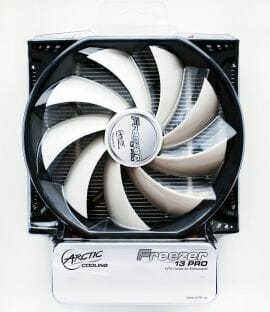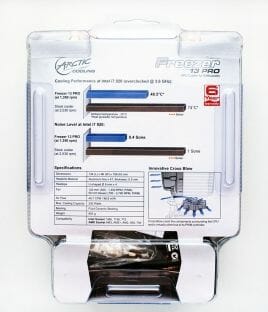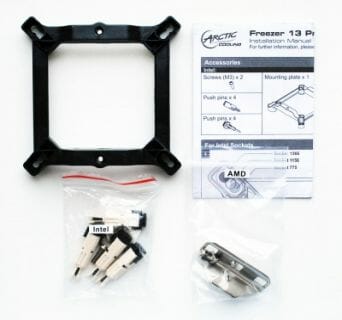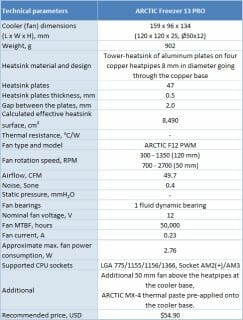ARCTIC’s Unlucky Number: Freezer 13 PRO Review

We are going to talk about a very promising new CPU cooler from ARCTIC, which, unfortunately, didn’t live up to our expectations.
In February of 2011 we tested a new cooler from the Swiss ARCTIC Company formerly known as Arctic Cooling. Back then Freezer 13 didn’t really make a big entrance, as it didn’t boast super-high cooling efficiency or very low level of noise. Nevertheless, we didn’t give it any negative feedback, because it cost relatively little money and therefore wasn’t expected to work any wonders.
At the same time, they announced a senior cooler model, ARCTIC Freezer 13 PRO, with a likely unlucky “13” model index in the name. And why we called it “unlucky”, you will soon find out.
Closer Look at ARCTIC Freezer 13 PRO
Packaging and Accessories
Although the company changed its name to ARCTIC, the packaging concept remained the same as before. All products are still sealed in clear plastic blisters with cardboard inserts inside:


This type of packaging is not particularly robust, because the plastic is fairly thin, but it allows you to see the entire cooler without opening the package or removing the cooler from it. The insert lists all cooler specifications, offers a few comparative performance charts and describes briefly the main distinguishing feature of the new cooler, which we are going to discuss later in this review.
At the bottom of the blister you see all bundled accessories including a plastic retention frame, user manual, four plastic mounts for the Intel platform, two steel brackets for the AMD platform and two screws:

ARCTIC Freezer 13 PRO is made in China. Its MSRP is set at $54.90 and covers 6-year warranty.
Technical Specifications and Recommended Pricing
The cooler specifications and pricing are summed up in the table below for your convenience:

Design and Functionality
ARCTIC Freezer 13 PRO looks very similar to its younger brother, but is much larger and heavier. It measures 159x96x134 mm and weighs 902 grams.
The heatsink is built around four copper heatpipes 8 mm in diameter. The heatpipes hold an array of 47 aluminum plates 0.5 mm thick that are pressed firmly against the heatpipes. The sides of the heatsink plates are bent downwards closing the gaps between the plates and there is a 120 mm fan on one of the wider sides.
There are no optimizations of the heatsink on the airflow entry. Its calculated effective surface size is 8490cm2, which is a decent size for a tower cooler.
The heatpipes are laid out lazily inside the heatsink body and only remotely resemble the classical staggered layout.
I can’t really tell what the ARCTIC engineers’ intention was when they decided on a layout like that. Obviously, most of the heatsink plate surface won’t really work at all, because it will be way too far from the heatpipes. Why didn’t they lay out the heatpipes at a greater distance from one another?
There is an additional 50 mm fan installed at the bottom of the heatsink right above the heatpipes. It is a unique distinguishing feature of the ARCTIC Freezer 13 PRO cooler.
Its major task is to cool the mainboard North Bridge and voltage regulator components around the processor socket. The rotation speed of this fan is adjusted automatically using PWM approach in the interval from 700 to 2700 RPM.
The primary fan in a plastic frame is 120x120x25 mm in size and in fact is none other but ARCTIC F12 PWM, which we have already tested earlier.
Its rotation speed changes together with the rotation speed of the small additional fan at the cooler base, but the supported speed ranges from 300 to 1350 RPM. The fan is supposed to create 49.7 CFM airflow, generate 0.4 Sone of noise and consume no more than 3 watts. Both fans are connected to the same power and monitoring cable, but the fan rotation speed monitoring is available only for the large fan.
ARCTIC Freezer 13 PRO comes with a layer of highly efficient ARCTIC MX-4 thermal paste applied to its base. Although, there is way too much of it.
Of course, this was ARCTIC’s attempt to make the installation procedure as quick and easy as possible, but we think it would be better to include a small tube of paste with the bundled accessories instead of wasting so much paste and even lowering the cooler efficiency.
Compatibility and Installation
ARCTIC Freezer 13 PRO is compatible with all contemporary platforms. The installation process is described in great detail in an online manual and is extremely simple. For example, you won’t need to remove the mainboard from the system case (only if you need it to remove the other cooler), because the cooler is fastened using a plastic frame with push-pins.
After that you need to place the cooler onto the CPU and secure it in place by tightening the two screws.That’s it. Now you have to connect the fan power cable to the mainboard and power on the system.
I have to add that the minimal distance from the mainboard to the lowest edge of the plastic fan frame is 40 mm, but even despite that ARCTIC Freezer 13 PRO won’t interfere with the memory modules featuring tall heat-spreaders.
Cooling Efficiency and Performance
We won’t have the traditional description of the testbed configuration and testing methodology today, because nothing has changed compared to our earlier articles. We are still using a well-ventilated system case with all of our traditional components. The room temperature during our test session is still at the same 24°C. And as for competitors, ARCTIC Freezer 13 PRO didn’t need any, because we were trying to figure out the cooler’s efficiency throughout the entire test session.
The thing is that this large and relatively well-equipped cooler simply refused to cool our six-core processor the way a cooler of its status and price should. We tried installing it two different ways (with the heatpipes going across and along the processor), we tried replacing the thermal paste with ARCTIC MX-2 applied in a thinner and more even layer, we checked and rechecked the retention pressure and even used additional washers to increase the hold even more. But all our efforts resulted in a very modest, or I should even say rather low, CPU overclocking result: 4.3 GHz at 1.39375 V Vcore and 95°C peak temperature of the hottest core.
Of course, it is better than 4.2 GHz at 1.335625 V and the same 95°C, which we saw by the junior ARCTIC Freezer 13, but unfortunately, this is a total fiasco compared with the competitors from the same and even lower price range. For example, the well-known Zalman CNPS10X Performa priced at about $40, cools the similarly overclocked processor 12 degrees better at 1000 RPM fan speed. Do I have to say that with such low overall efficiency the additional small fan at the bottom doesn’t really matter? Anyway, disabling this little fan didn’t have any effect on the results.
Conclusion
Looks like the number “13” is indeed an unlucky number for ARCTIC. After all how else could we explain such low cooling efficiency of their new ARCTIC Freezer 13 PRO cooler? Yes, its design has a few issues, such as non-optimal heatpipes layout inside the heatsink body, use of pressing instead of soldering for the heatsink structure, lack of heatsink optimizations on airflow entry and insufficient pressure provided by the cooler retention. Nevertheless, even with all these issues, the cooler should work better than what we have just seen. Since the junior model we discussed before also doesn’t break any performance records, we dare assume that ARCTIC uses not the most efficient heatpipes, even though all the leaders in this field such as Zalman and Thermalright have already switched.
Anyway, we can’t recommend ARCTIC Freezer 13 PRO, even if simple installation is what you are after in the first place. And we would certainly wish the company famous for making the best VGA coolers out there and remarkable thermal interfaces to really focus on improving the cooling efficiency of their CPU products and maybe even remove the notorious number “13” from their model names, just in case.